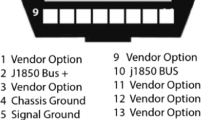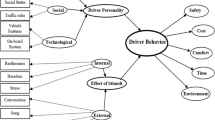Abstract
A shift schedule modification program is an intelligent system for automatic transmission. This program can adjust shift points to cater to drivers with different driving habits. An important prerequisite in designing a personalized shift schedule is identifying the driving habits of drivers. In this study, we developed an identification algorithm based on wavelet neural network and Bayesian fusion decision-making. First, a system for identifying driving styles was established based on the wavelet neural network. Second, the results were integrated by Bayesian fusion decision-making to obtain the driving habits. Finally, different correction coefficients were selected based on driving habits to satisfy the requirements of drivers. Experimental results show that the driving habits can be accurately identified based on wavelet neural network and Bayesian fusion decision-making, and the correction control strategy can rectify the shift schedule effectively. The correction control strategy satisfies the requirements of different drivers for vehicle performance and enhances the intelligence of automatic transmission.
Similar content being viewed by others
Abbreviations
- M :
-
number of input layer nodes
- L :
-
number of hidden layer nodes
- N :
-
number of output layer nodes
- K :
-
type of driving style
- ωmn :
-
n-th identification result in m-th effective working condition
- γ :
-
style tolerance
- ε :
-
probability tolerance
- l s :
-
normalization coefficient
- V :
-
vehicle speed at shift, km/h
- v d :
-
power shift speed, km/h
- v e :
-
economic shift speed, km/h
- a :
-
dynamic coefficient
- b :
-
economic coefficient
- T ed :
-
engine dynamic output torque, N.m
- T e :
-
engine steady-state output torque, N.m
- λ :
-
decreasing coefficient
- W e :
-
angular speed of the engine output crankshaft, rad/s
- T out :
-
transmission output torque, N.m
- i g :
-
transmission ratio
- η T :
-
efficiency of the transmission system
- F f :
-
rolling resistance, N.m
- F w :
-
air resistance, N.m
- F i :
-
slope resistance, N.m
- F j :
-
acceleration resistance, N.m
- C D :
-
air resistance coefficient
- A :
-
vehicle frontal area, m2
- v a :
-
vehicle speed, km/h
- f 0 :
-
rolling resistance coefficient
- σ :
-
mass conversion factor
- i 0 :
-
transmission ratio of the main reducer
- F t :
-
driving force, N.m
- R :
-
effective rolling radius, m
References
Bengler, K., Dietmayer, K., Farber, B., Maurer, M., Stiller, C. and Winner, H. (2014). Three decades of driver assistance systems: review and future perspectives. IEEE Intelligent Transportation Systems Magazine6, 5, 6–22.
Birrell, S. A., Fowkes, M. and Jennings, P. (2014). Effect of using an in-vehicle smart driving aid on real-world driver performance. IEEE Trans. Intelligent Transportation Systems15, 5, 1801–1810.
Chen, S., Fang, C. and Tien, C. (2013). Driving behavior modelling system based on graph construction. Transportation Research Part C: Emerging Technologies, 26, 314–330.
Dong, Y. C., Hu, Z. C., Uchimura, K. and Murayama, N. (2011). Driver inattention monitoring system for intelligent vehicles: A review. IEEE Trans. Intelligent Transportation Systems12, 5, 596–614.
Dörr, D., Grabengiesser, D. and Gauterin, F. (2014). Online driving style recognition using fuzzy logic. Proc. 17th Int. IEEE Conf. Intelligent Transportation Systems (ITSC), Qingdao, China.
Du, C. P., Yan, F. W., Yan, Y. B. and Yang, P. L. (2008). Methods of engine torque estimation for control algorithms. Transactions of Csice26, 5, 446–451.
Eboli, L., Mazzulla, G. and Pungillo, G. (2017). The influence of physical and emotional factors on driving style of car drivers: A survey design. Travel Behaviour and Society, 7, 43–51.
Ge, A. L., Jiang, J. J., Wu, W. Z. and Chen, J. H. (1991). Research on dynamic 3-parameter shift schedule of automatic transmission. Proc. 6th Int. Pacific Conf. Automotive Engineering, Seoul, Korea.
Hajfraj, A. and Pfeiffer, F. (1999). Dynamic modeling and analysis of automatic transmissions. Proc. IEEE/ASME Int. Conf. Advanced Intelligent Mechatronics, Atlanta, Georgia, USA.
He, C. Z., Qin, W. B., Ozay, N. and Orosz, G. (2017). Optimal gear shift schedule design for automated vehicles: Hybrid system based analytical approach. IEEE Trans. Control Systems Technology26, 5, 1–13.
He, S. Q. and Du, A. M. (2007). Research on simulation model of gasoline engine based on torque control. Proc. IEEE Int. Conf. Vehicular Electronics and Safety, Shanghai, China.
Huang, S. and Wang, H. (2016). Status analysis and strategy research of chinese automobile aftermarket. Information Recording Materials17, 5, 127–128.
Huysduynen, H. H. V., Terken, J., Martens, B. and Eggen, B. (2015). Measuring driving styles: A validation of the multidimensional driving style inventory. Proc. 7th Int. Conf. Automotive User Interfaces and Interactive Vehicluar Applications, Nottingham, UK.
Jo, H. S., Jo, S. T., Lee, J. M. and Park, Y. (2001). Analysis of the shift characteristics of an automated manual transmission in the parallel type hybrid drivetrain system of a transit bus. Int. J. Heavy Vehicle Systems8, 5, 60–82.
Langari, R. and Won, J. (2005). Intelligent energy management agent for a parallel hybrid vehicle-Part I: System architecture and design of the driving situation identification process. IEEE Trans. Vehicular Technology54, 5, 925–934.
Lei, Y. L., Liu, K., Fu, Y., Li, X. Z., Liu, Z. J. and Sun, S. H. (2016). Research on driving style recognition method based on drivers dynamic demand. Advances in Mechanical Engineering8, 5, 1–14.
Li, G. Q. and Görges, D. (2018). Optimal control of the gear shifting process for shift smoothness in dual-clutch transmissions. Mechanical Systems and Signal Processing, 103, 23–38.
Li, Z., Li, H., He, H. and Peng, J. (2018). Three-parameter shift Schedule of automatic mechanical transmission for electric bus. Energy Procedia, 145, 504–509.
Lu, J. Y., Xie, X. F. and Zhang, R. G. (2013). Focusing on appraisals: How and why anger and fear influence driving risk perception. J. Safety Research45, 5, 65–73.
Ly, M. V., Martin, S. and Trivedi, M. M. (2013). Driver classification and driving style recognition using inertial sensors. Proc. IEEE Intelligent Vehicles Symp., Gold Coast, Queensland, Australia.
Manzoni, V., Corti, A., Savaresi, S. M. and Luca, P. D. (2010). Driving style estimation via inertial measurements. Proc. Int. IEEE Conf. Intelligent Transportation Systems, Funchal, Portugal.
Martinez, C. M., Heucke, M., Wang, F. Y., Gao, B. and Cao, D. P. (2018). Driving style recognition for intelligent vehicle control and advanced driver assistance: A survey. IEEE Trans. Intelligent Transportation Systems19, 5, 666–676.
Meiring, G. A. M. and Myburgh, H. C. (2015). A review of intelligent driving style analysis systems and related artificial intelligence algorithms. Sensors15, 5, 30653–30682.
Meng, F. J. and Jin, H. (2018). Slope shift strategy for automatic transmission vehicles based on the road gradient. Int. J. Automotive Technology19, 5, 509–521.
Mudgal, A., Hallmark, S., Carriquiry, A. and Gkritza, K. (2014). Driving behavior at a roundabout: A hierarchical bayesian regression analysis. Transportation Research Part D: Transport and Environment, 26, 20–26.
Murphey, Y. L., Milton, R. and Kiliaris, L. (2009). Driver’s style classification using jerk analysis. Proc. IEEE Workshop on Computational Intelligence in Vehicles and Vehicular Systems, Nashville, Tennessee, USA.
Ohn-Bar, E. and Trivedi, M. M. (2016). Looking at humans in the age of self-driving and highly automated vehicle. IEEE Trans. Intelligent Vehicles1, 5, 90–104.
Pettersson, M. and Nielsen, L. (2000). Gear shifting by engine control. IEEE Trans. Control Systems Technology8, 5, 495–507.
Sakaguchi, S., Sakai, I. and Haga, T. (1993). Application of fuzzy logic to shift scheduling method for automatic transmission. Proc. 2nd IEEE Int. Conf. Fuzzy Systems, San Francisco, California, USA.
Son, J., Park, M., Won, K. and Stewart, A. B. (2016). Comparative study between Korea and UK: Relationship between driving style and real-world fuel consumption. Int. J. Automotive Technology17, 5, 175–181.
Wang, R. and Lukic, S. M. (2011). Review of driving conditions prediction and driving style recognition based control algorithms for hybrid electric vehicles. Proc. IEEE Vehicle Power and Propulsion Conf., Chicago, Illinois, USA.
Xu, L., Zhang, J., Shi, B. and Meng, W. (2018). Automating shift-scheduling calibration by using bionic optimization and personalized driver models. IEEE Trans. Intelligent Transportation Systems, 1–10.
Zhai, W. M., Wang, K. Y. and Cai, C. B. (2009). Fundamentals of vehicle-track coupled dynamics. Vehicle System Dynamics: Int. J. Vehicle Mechanics and Mobility47, 5, 1349–1376.
Zhang, J. P., Wang, F. Y., Wang, K. F., Lin, W. H., Xu, X. and Chen, C. (2011). Data-driven intelligent transportation systems: A survey. IEEE Trans. Intelligent Transportation Systems12, 5, 1624–1639.
Zhang, Q. H. and Benveniste, A. (1992). Wavelet networks. IEEE Trans. Neural Networks3, 5, 889–898.
Zhuang, W. C., Zhang, X. W., Yin, G. D., Peng, H. E. and Wang, L. M. (2019). Mode shift schedule and control strategy design of multimode hybrid powertrain. IEEE Trans. Control Systems Technology, 1–12.
Acknowledgement
This research was supported by the National Natural Science Foundation of China (Grant No. 51875151), Key R&D projects of Anhui Province (Grant No. 2017030701043 and 1804a09020017) and National Key R&D Program of China (Grant No. 2016YFD0700604).
Author information
Authors and Affiliations
Corresponding author
Additional information
Publisher’s Note
Springer Nature remains neutral with regard to jurisdictional claims in published maps and institutional affiliations.
Rights and permissions
About this article
Cite this article
Xia, G., Gao, J., Tang, X. et al. Control Strategy for Shift Schedule Correction Based on Driving Habits for Vehicles with Automatic Transmission. Int.J Automot. Technol. 21, 407–418 (2020). https://doi.org/10.1007/s12239-020-0038-3
Received:
Revised:
Accepted:
Published:
Issue Date:
DOI: https://doi.org/10.1007/s12239-020-0038-3




